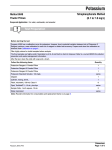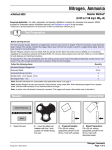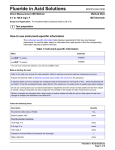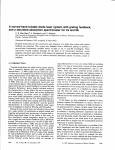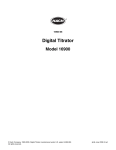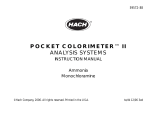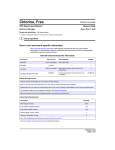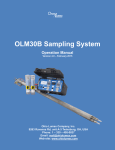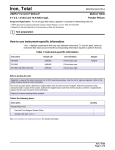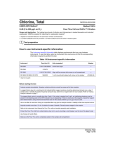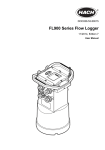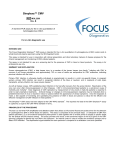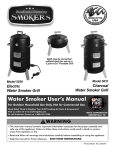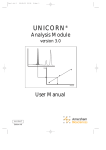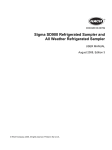Download Method 8033
Transcript
Lead (Method 8033 Dithizone Method1 Powder Pillows (3 to 300 µg/L) Scope and Application: For water and wastewater; USEPA accepted for reporting for wastewater analysis (digestion is required).2 1 Adapted from Snyder, L. J., Analytical Chemistry, 19 684 (1947). is equivalent to Standard Method 3500-Pb D for wastewater analysis. 2 Procedure Test Preparation Before starting the test: For more accurate results, determine a reagent blank value for each new lot of reagent. Follow the procedure using deionized water instead of the sample. Clean all glassware with a 1:1 Nitric Acid Solution. Rinse with deionized water. Cloudy and turbid samples may require filtering before running the test. Report results as µg/L soluble lead. Use glass membrane type filter to avoid loss of lead by adsorption onto the filter paper. If samples cannot be analyzed immediately, see Sample Collection, Preservation, and Storage on page 5. Adjust the pH of preserved samples before analysis. For more accurate results, adjust the sample to pH 11.0–11.5 using a pH meter in Step 10. Omit the five additional drops of Sodium Hydroxide Standard Solution in Step 11 The DithiVer powder will not completely dissolve in the chloroform. For further notes see DithiVer Solution Preparation, Storage, and Reagent Blank on page 5. Read the MSDS before testing. Spilled reagent will affect test accuracy and is hazardous to skin and other materials. Collect the following items: Quantity Citrate Buffer Powder Pillows 1 Chloroform 500 mL DithiVer Metals Reagent Powder Pillows 1 Lead Reagent Set 1 Potassium Cyanide 2g Sodium Hydroxide solution, 5.0 N 5 mL Sodium Hydroxide Standard Solution, 5.0 N varies Cotton Balls 1 Clippers 1 Cylinder, 50-mL graduated mixing 1 Cylinder, 5-mL graduated 1 Cylinder, 50-mL graduated 1 Cylinder, 250-mL graduated 1 Funnel, 500-mL separatory 1 Sample Cells, 1-inch square, 25-mL 2 Spoon, measuring, 1.0-g 1 Support Ring (4-inch) and Stand (5 x 8-inch base) 1 Note: Reorder information for consumables and replacement items is on page 6. Lead_8033_Dithizone.fm Lead Page 1 of 8 Lead (3 to 300 µg/L) Powder Pillows Method 8033 DANGER Cyanide is a deadly poison. Use a fume hood. Maintain cyanide solutions at pH 11 or greater to prevent formation of cyanide gas. 1. Select the test. 2. Insert the Multi-cell Adapter with the 1-inch square cell holder facing the user. 3. Fill a 250-mL graduated cylinder to the 250-mL mark with sample. 4. Transfer the sample into 500-mL separatory funnel. 5. Add the contents of one Buffer Powder Pillow for heavy metals, citrate type. 6. DithiVer Solution Preparation: Add 50 mL of chloroform to a 50-mL mixing graduated cylinder. Add the contents of one DithiVer Metals Reagent Powder Pillow. 7. Measure 30 mL of the prepared dithizone solution with a second graduated cylinder and add to the separatory funnel. 8. Add 5 mL of 5.0 N Sodium Hydroxide Standard Solution. Stopper the funnel and shake to dissolve. Stopper the cylinder. Invert several times to mix. Lead Page 2 of 8 Stopper and invert to mix. Open stopcock to vent. Close the stopcock. Lead_8033_Dithizone.fm Lead (3 to 300 µg/L) 9. Stopper. Invert. Open stopcock to vent. Close the stopcock and shake the funnel once or twice and vent again. Note: Add a few drops of 5.25 N Sulfuric Acid Standard Solution if the solution turns orange on shaking. The blue-green color will reappear. To avoid higher blanks, repeat procedure on new sample and use less sodium hydroxide in step 8. 10. Continue adding 5.0 N Sodium Hydroxide Standard Solution dropwise and shaking the funnel after every few drops until the color of the solution being shaken changes from blue-green to orange. Large amounts of zinc cause the color transition at the end point to be indistinct. 11. Add 5 more drops of 5.0 N Sodium Hydroxide Standard Solution. A pink color in the bottom (chloroform) layer at this point does not necessarily indicate lead is present. Only after adding the potassium cyanide in the next step will the presence of lead be confirmed by a pink color. 12. Add 2 heaping 1.0-g scoops of potassium cyanide to the funnel. Stopper. Shake vigorously until the potassium cyanide is all dissolved (about 15 seconds). HRS MIN SEC 13. Wait one minute for the layers to separate. The bottom (chloroform) layer will be pink if lead is present. 14. Prepared Sample: Insert a cotton plug the size of a pea into the delivery tube of the funnel and slowly drain the bottom (chloroform) layer into a dry 25-mL square sample cell. Stopper. 15. Blank Preparation: Fill another 25-mL square sample cell with chloroform. Stopper. 16. Insert the blank into the cell holder with the fill line facing the user. The lead-dithizone complex is stable for at least thirty minutes if the sample cell is kept tightly capped and out of direct sunlight. Lead_8033_Dithizone.fm Lead Page 3 of 8 Lead (3 to 300 µg/L) 17. Press ZERO. The display will show: 0 µg/L Pb 2+ 18. Insert the prepared sample into the cell holder with the fill line facing the user. Results are in µg/L Pb 2+. Interferences Table 1 Interfering Substances and Levels Interfering Substance Interference Levels and Treatments Highly buffered samples or extreme sample pH All levels. See procedure below. Bismuth All levels. See procedure below. Copper All levels. See procedure below. Mercury All levels. See procedure below. Silver All levels. See procedure below. Tin All levels. See procedure below. Table 2 Substances That Do Not Interfere Aluminum Lead Antimony Magnesium Arsenic Manganese Calcium Nickel Chromium Tin Cobalt Iron Zinc Eliminate interference from the metals in Table 1 by the following treatment, beginning after Step 6. 1. Measure about 5-mL of the DithiVer solution into the separatory funnel. Stopper the funnel, invert and open the stopcock to vent. Close the stopcock and shake the solution vigorously for 15 seconds. Allow the funnel to stand undisturbed until the layers separate (about 30 seconds). A yellow, red, or bronze color in the bottom (chloroform) layer confirms the presence of interfering metals. Draw off and collect the bottom (chloroform) layer for proper disposal. Lead Page 4 of 8 Lead_8033_Dithizone.fm Lead (3 to 300 µg/L) 2. Repeat extraction with fresh 5-mL portions of prepared dithizone solution (collecting the bottom layer each time in appropriate waste collection vessel) until the bottom layer shows a pure dark green color for three successive extracts. Extractions can be repeated a number of times without appreciably affecting the amount of lead in the sample. 3. Extract the solution with several 2 or 3 mL portions of pure chloroform to remove any remaining dithizone, again collecting the bottom layer each time for proper disposal. 4. Continue the procedure, substituting 28.5 mL of prepared dithizone solution for the 30 mL in Step 7. DithiVer Solution Preparation, Storage, and Reagent Blank Store DithiVer Powder Pillows away from light and heat. A convenient way to prepare this solution is to add the contents of 10 DithiVer Metals Reagent Powder Pillows to a 500-mL bottle of chloroform and invert several times until well mixed (carrier powder may not dissolve). Store dithizone solution in an amber glass bottle. This solution is stable for 24 hours. A reagent blank using deionized water should be carried out through the entire method to obtain the most accurate results. Sample Collection, Preservation, and Storage Collect samples in an acid-washed glass or plastic containers. Adjust the pH to 2 or less with nitric acid (about 2 mL per liter). Store preserved samples up to six months at room temperature. Adjust the pH to 2.5 with 5.0 N sodium hydroxide before analysis. Correct the test result for volume additions. Accuracy Check 1. Leave the unspiked sample in the sample cell compartment. Verify that the units displayed are in µg/L. 2. Press OPTIONS>MORE. Press STANDARD ADDITIONS. A summary of the standard additions procedure will appear. 3. Press OK to accept the default values for standard concentration, sample volume, and spike volumes. Press EDIT to change these values. After values are accepted, the unspiked sample reading will appear in top row. See the user manual for more information. 4. Snap the neck off a Lead Voluette Ampule Standard, 50-mg/L Pb. 5. Use the TenSette® Pipet (do not use a glass pipet) to add 0.1 mL, 0.2 mL, and 0.3 mL of standard, respectively to three 250-mL samples and mix each thoroughly. 6. Analyze each standard addition sample as described above. Accept the standard additions reading by pressing the soft key under READ each time. Each addition should reflect approximately 100% recovery. 7. After completing the sequence, press GRAPH to view the best-fit line through the standard additions data points, accounting for the matrix interferences. Press IDEAL LINE to view the relationship between the sample spikes and the “Ideal Line” of 100% recovery. Lead_8033_Dithizone.fm Lead Page 5 of 8 Lead (3 to 300 µg/L) Standard Solution Method 1. Prepare a 10-mg/L lead standard solution by pipetting 10.00 mL of Lead Standard Solution, 100-mg/L, into a 100-mL volumetric flask. 2. Add 0.2 mL of concentrated nitric acid using a TenSette Pipet to prevent the adsorption of lead onto the container walls. Dilute to the mark with deionized water and mix thoroughly. 3. To make a 200-µg/L standard, pipet 5.00 mL of the 10.0-mg/L standard into 245 mL of deionized water in the 500-mL separatory funnel in Step 4 of the Dithizone procedure. Prepare these solutions daily. Perform the lead procedure as described above. 4. To adjust the calibration curve using the reading obtained with the standard solution, press OPTIONS>MORE on the current program menu. Press STANDARD ADJUST. 5. Press ON. Press ADJUST to accept the displayed concentration. If an alternate concentration is used, press the number in the box to enter the actual concentration, then press OK. Press ADJUST. Method Performance Precision Standard: 150 µg/L Pb Program 95% Confidence Limits of Distribution 280 140–160 µg/L Pb Sensitivity Portion of Curve: ∆Abs ∆Concentration Entire Range 0.010 2.3 µg/L Summary of Method The dithizone method is designed for the determination of lead in water and wastewater. The DithiVer Metals Reagent is a stable powder form of dithizone. Lead ions in basic solution react with dithizone to form a pink to red lead-dithizonate complex, which is extracted with chloroform. Test results are measured at 515 nm. Consumables and Replacement Items Required Reagents Description Lead Reagent Set (100 Tests) Quantity/Test Unit Cat. No. — — 22431-00 1 100/pkg 14202-99 30 mL 4L 14458-17 1 100/pkg 12616-99 Includes: (1) 14202-99, (2) 14458-17, (1) 12616-99, (2) 767-14, (1) 2450-53, (2) 2450-26 Buffer Powder Pillows, citrate Chloroform, ACS DithiVer Metals Reagent Powder Pillows Potassium Cyanide 0.1 g 125 g 767-14 Sodium Hydroxide Solution, 5.0 N 5 mL 1000 mL 2450-53 Sodium Hydroxide Standard Solution, 5.0 N varies 59 mL DB 2450-26 Lead Page 6 of 8 Lead_8033_Dithizone.fm Lead (3 to 300 µg/L) Required Apparatus Description Quantity/Test Unit Cat. No. Clippers, for opening powder pillows 1 each 968-00 Cotton Balls, absorbent 1 100/pkg 2572-01 Cylinder, graduated, 5-mL 1 each 508-37 Cylinder, graduated, 50-mL 1 each 508-41 Cylinder, graduated, 250-mL 1 each 508-46 Cylinder, graduated, mixing, 50-mL 1 each 1896-41 Funnel, separatory, 500-mL 1 each 520-49 pH Meter, sension™1, portable, with electrode 1 each 51700-10 Sample Cell, 1-inch square, 25 mL with cap 2 2/pkg 26126-02 Spoon, measuring,1-g 1 each 510-00 Support Ring, 4" 1 each 580-01 Support Ring Stand, 5" x 8" base 1 each 563-00 Unit Cat. No. Lead Standard Solution, 100 mg/L Pb 100 mL 12617-42 Lead Standard Solution, 10-mL Voluette Ampules, 50-mg/L Pb 16/pkg 14262-10 Description Unit Cat. No. Ampule Breaker Kit each 21968-00 Chloroform, ACS 500 mL 14458-49 Filter Discs, glass, 47 mm 100/pkg 2530-00 Filter Holder, glass, for 47-mm filter each 2340-00 Flask, Erlenmeyer, 500-mL each 505-49 Recommended Standards Description Optional Reagents and Apparatus Flask, filtering, 500-mL each 546-49 Flask, volumetric, Class A, 100-mL each 14574-42 Nitric Acid Solution, 1:1 500 mL 2540-49 Nitric Acid, ACS 500 mL 152-49 pH Paper, pH 1.0 to 11.0 5 rolls/pkg 391-33 Pipet, serological, 2-mL each 532-36 Pipet, TenSette®, 0.1 to 1.0 mL each 19700-01 50/pkg 21856-96 Pipet, volumetric, 5.00-mL, Class A each 14515-37 Pipet, volumetric, 10.00-mL, Class A each 14515-38 Pipet Filler, safety bulb each 14651-00 100 mL MDB 2449-32 4 liters 272-56 Pipet Tips, for TenSette Pipet 19700-01 Sulfuric Acid, 5.25 N Water, deionized Lead_8033_Dithizone.fm Lead Page 7 of 8 FOR TECHNICAL ASSISTANCE, PRICE INFORMATION AND ORDERING: In the U.S.A. – Call toll-free 800-227-4224 Outside the U.S.A. – Contact the HACH office or distributor serving you. On the Worldwide Web – www.hach.com; E-mail – [email protected] © Hach Company, 2005. All rights reserved. Printed in Germany. HACH COMPANY WORLD HEADQUARTERS Telephone: (970) 669-3050 FAX: (970) 669-2932 Updated April 05 Edition 1









